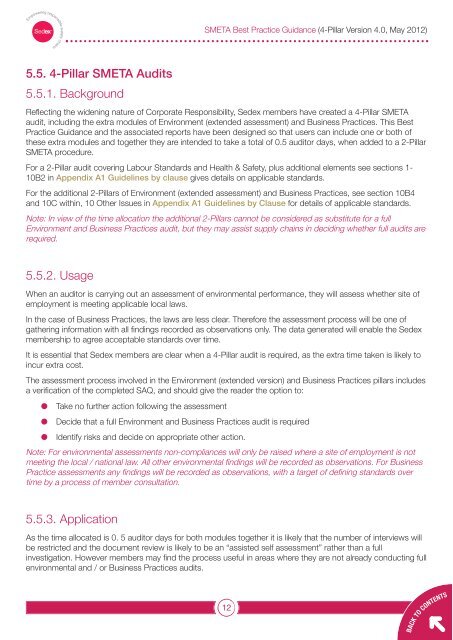Sedex Members Ethical Trade Audit (SMETA) Best Practice Guidance
Sedex Members Ethical Trade Audit (SMETA) Best Practice Guidance
Sedex Members Ethical Trade Audit (SMETA) Best Practice Guidance
Create successful ePaper yourself
Turn your PDF publications into a flip-book with our unique Google optimized e-Paper software.
5.5. 4-Pillar <strong>SMETA</strong> <strong>Audit</strong>s<br />
5.5.1. Background<br />
Reflecting the widening nature of Corporate Responsibility, <strong>Sedex</strong> members have created a 4-Pillar <strong>SMETA</strong><br />
audit, including the extra modules of Environment (extended assessment) and Business <strong>Practice</strong>s. This <strong>Best</strong><br />
<strong>Practice</strong> <strong>Guidance</strong> and the associated reports have been designed so that users can include one or both of<br />
these extra modules and together they are intended to take a total of 0.5 auditor days, when added to a 2-Pillar<br />
<strong>SMETA</strong> procedure.<br />
For a 2-Pillar audit covering Labour Standards and Health & Safety, plus additional elements see sections 1-<br />
10B2 in Appendix A1 Guidelines by clause gives details on applicable standards.<br />
For the additional 2-Pillars of Environment (extended assessment) and Business <strong>Practice</strong>s, see section 10B4<br />
and 10C within, 10 Other Issues in Appendix A1 Guidelines by Clause for details of applicable standards.<br />
Note: In view of the time allocation the additional 2-Pillars cannot be considered as substitute for a full<br />
Environment and Business <strong>Practice</strong>s audit, but they may assist supply chains in deciding whether full audits are<br />
required.<br />
5.5.2. Usage<br />
When an auditor is carrying out an assessment of environmental performance, they will assess whether site of<br />
employment is meeting applicable local laws.<br />
In the case of Business <strong>Practice</strong>s, the laws are less clear. Therefore the assessment process will be one of<br />
gathering information with all findings recorded as observations only. The data generated will enable the <strong>Sedex</strong><br />
membership to agree acceptable standards over time.<br />
It is essential that <strong>Sedex</strong> members are clear when a 4-Pillar audit is required, as the extra time taken is likely to<br />
incur extra cost.<br />
The assessment process involved in the Environment (extended version) and Business <strong>Practice</strong>s pillars includes<br />
a verification of the completed SAQ, and should give the reader the option to:<br />
l Take no further action following the assessment<br />
l Decide that a full Environment and Business <strong>Practice</strong>s audit is required<br />
l Identify risks and decide on appropriate other action.<br />
Note: For environmental assessments non-compliances will only be raised where a site of employment is not<br />
meeting the local / national law. All other environmental findings will be recorded as observations. For Business<br />
<strong>Practice</strong> assessments any findings will be recorded as observations, with a target of defining standards over<br />
time by a process of member consultation.<br />
5.5.3. Application<br />
<strong>SMETA</strong> <strong>Best</strong> <strong>Practice</strong> <strong>Guidance</strong> (4-Pillar Version 4.0, May 2012)<br />
As the time allocated is 0. 5 auditor days for both modules together it is likely that the number of interviews will<br />
be restricted and the document review is likely to be an “assisted self assessment” rather than a full<br />
investigation. However members may find the process useful in areas where they are not already conducting full<br />
environmental and / or Business <strong>Practice</strong>s audits.<br />
12<br />
BACK TO CONTENTS


